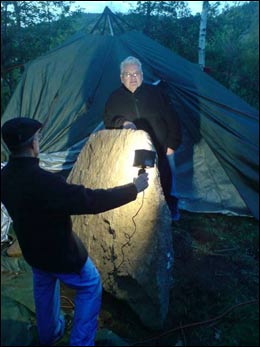
© VGThe stone was found in Arnstein Henriksen's yard in Hogganvik, Mandal in Vest-Agder county.
Experts are now examining a unique rune stone dating back to around 400 AD, discovered in a garden in the city of Mandal in Southern Norway a week ago. The find may also contain a grave,
reports Norway Post.
This is the first rune stone discovered in Norway since 1947, and the find is described as a sensation by the experts.
There are several lines of runes cut into the face of the stone, but it seems the style of writing is a bit different from earlier finds, and more difficult to desipher.
However, it is determined that one sentence begins "Ek Naudigastir" (I Naudagistr). It is believed Naugadistr is a man's name.
Under the rune stone there is also another large stone, which may cover what the experts believe to be a grave, since another grave was discovered on the same property around 20 years ago.
